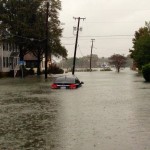 By Peter Galuszka
By Peter Galuszka
Ten days later, New York City and parts of the New Jersey and New York coast are still reeling from Super Storm Sandy as yet another nor’easter packing 50 mile per hour winds approaches.
Scientific evidence points out that sea level rises caused by melting polar icecaps caused, in turn, by climate change, are part of the problem. One city that would suffer devastating floods had Sandy hit or a more typical Category Two or Three hurricane comes is Norfolk.
According to a NPR story, there’s clear evidence that water levels are rising around Norfolk. Larry Atkinson, an oceanographer at Old Dominion University says one can tell by looking at the high water marks left on a decades-old sea wall that protects Norfolk’s downtown. The high water brown mark is consistently going higher and during Hurricane Irene last year, the mark was over the top of the wall.
NPR says that one problem is that as icepacks melt because of global warming, the resulting seawater is not being distributed equally around the oceans. It’s like stirring water in a glass with a spoon. Water closest to the glass is higher than that in the center. Exchange the image of the spoon with swirling ocean currents and you get the idea.
For some reason, the Atlantic Coast of the U.S. from about North Carolina northwards is collecting more high water than parts of the coast to the south. It isn’t clear why, but it may explain why Sandy had such a wallop even though it started as a weak Category One hurricane, NPR says..
In Tidewater, another Sandy would be devastating to the Virginia economy and not just in terms of beach houses and tourism lost. Flooded might be Tidewater’s enormous drydocks at shipyards employing 20,000 or more people. The 4,000 people who work at NASA’s Langley Research Center wouldn’t be able to go to work if their homes are flooded even if the runways are protecting from rising waters.
This adds a dark new dimension to the argument about climate change and living in coastal areas. Some posts on Bacons Rebellion have dealt with the issue before and have (believe or not) acknowledged that sea levels are rising. This Bacons Rebellion post does just that but deals mostly with the issue of flood insurance and bad planning.
All true, but the new issue deals with long-term impacts on jobs that are inextricably linked to living near water, such as working at a shipyard, a port facility or a military or scientific installation. It’s a much bigger deal than summer fun in the sun and sand.
A solution could be a $1 billion seawall that might protect some of Norfolk’s neighborhoods. A similar seawall has been pitched around New York running across the mouth of the harbor and also near Hell Gate where the East River meets Long Island Sound. That cost is about $6 billion.
NPR says that a Dutch company has advised Norfolk about such a defense. That makes sense because The Netherlands has centuries of experience dealing with low-lying land.
But Norfolk simply doesn’t have the $1 billion and it’s doubtful New York does, either.
The issue is no longer one of merely complaining about building waterfront homes and insuring them. The new dynamics of ice floes melting and uneven water levels rising is giving the matter new urgency.


